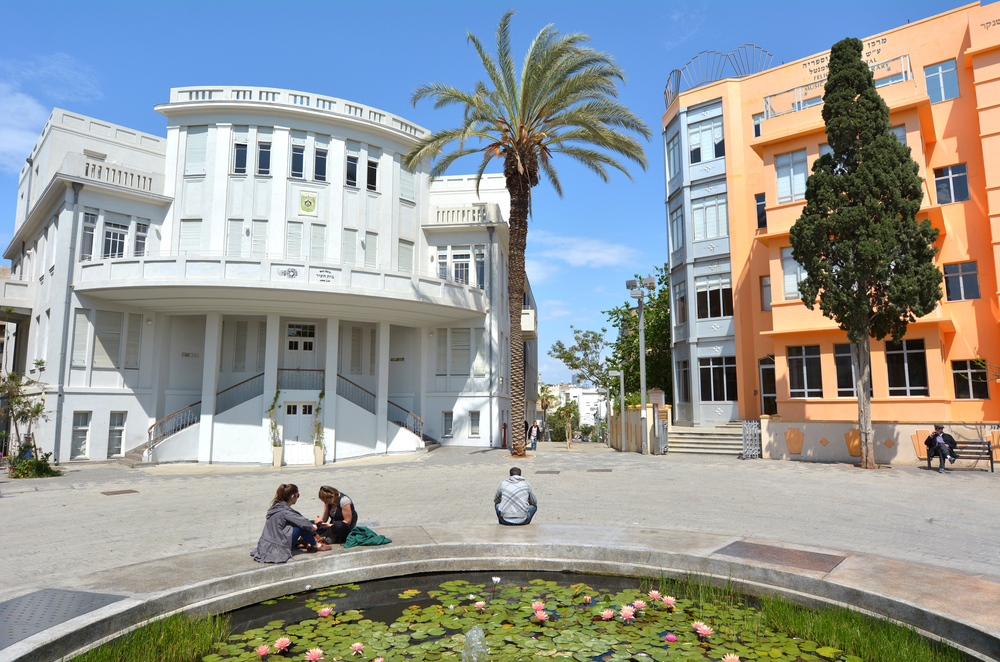Bialik Street, Tel Aviv
Just a few steps from busy, smog-filled Allenby Street, is Bialik Street, an elegant and beautiful 300-meter-long stretch of street lined with some of the most exquisite buildings in Tel Aviv. Bialik Street was once the hub of Tel Aviv, in the heart of a vibrant neighborhood where some of the most famous poets and literary figures lived. Imagine prominent figures coming and going from City Hall in Bialik Square, artists, and literary stars meeting at the cafes on Bialik Street to discuss their latest creations, and intellectuals gathering in the homes of illustrious leaders. This street is packed with architectural gems and stories of the history of early Tel Aviv.
Many of the former homes of famous artists have been turned into house museums, and the street has several restored and preserved historic buildings in the iconic Bauhaus style. It is considered one of the most photogenic streets in Tel Aviv.

Bialik Square, where the first Tel Aviv city town hall was located
Bialik Street is sandwiched between some of the city’s most popular and interesting landmarks. Bialik runs from Allenby Street in the south to Idelson Street in the north where Bialik Street ends at Bialik Square.
Plan Your Visit
- Location - Bialik Street, Tel Aviv
- Open Times - 24/7. Beit Ha’Ir: Sun closed, Mon-Thu 09:00-18:00, Fri 09:00-14:00, Sat 10:00-16:00. Bauhaus Museum: Sun-Thu 09:30-20:00, Fri 09:30-15:00, Sat closed. Rubin Museum: Mon, Wed-Fri 10:00-15:00 Tues 10:00-20:00. Sat 11:00-14:00. Bialik Museum: Mon-Wed 09:00-17:00, Thu 09:00-19:00, Fri-Sat 10:00-14:00, Sun closed. Music Center: Sun; Tues 9:00-13:45 Mon- Wed, Thurs 12:00-18:45.
- Prices - Free. Beit Ha’Ir 40/20 ILS, Bauhaus Museum free, Rubin Museum 30/15 ILS. Bialik Museum 35 ILS.
- Average Visit Duration - 1 hour
- Tours - The only way to understand the rich history of Bialik Street is through one of the Tel Aviv guided tours.
See and Do on Bialik Street Tel Aviv
The Cafes at #9 and #2 Bialik Street
At #9 is another stunning building constructed in 1928 in the eclectic style. In the past, it housed a well-known cafe frequented by prominent historical figures, including Bialik, David Ben Gurion, Disengoff, and even Albert Einstein.
Across the street is #2 where another famous coffee house once welcomed other intellectuals and literary figures. The building at #2 was constructed in the 1930s in the Bauhaus style and called Gan Raveh. At one point the restaurant moved onto the rooftop of the building where diners were surrounded by the rooftop garden’s lush plants. The building still houses a coffee shop, Cafe Bialik, where you can join locals for a cup of coffee.
#14 Rubin House
Designed in the International style in 1954 this house was home to artist Reuven Rubin, who was a close friend of Bialik. When Rubin died in 1974 his home was converted to a museum. Here you can see a gallery of his work, attend workshops, and see the restored studio where the artist worked.
#15 Bialik Street Goldberg House
This building was constructed in 1929 in the Art Deco style. It is the former home of Dina Shoshana Goldberg. Ask your tour guide about the mysterious theft and recovery of the sign that hangs outside this house.
#19 Bialik Street Synagogue
The building at #19 was rented to a rabbi from Husiatin, Ukraine in 1936 and became the Tel Aviv Hasidic Center. Since then it has functioned as a synagogue.
#21 Bauhaus Foundation Museum
At #21 Bialik Street is a museum dedicated to the architectural style that has earned Tel Aviv UNESCO status. The building itself is in the Bauhaus style and has four stories. The museum displays a collection of furniture and household decor in the Bauhaus style.
Pro Tip: The adjacent building was built in 1922 and has a fascinating history, which you can discover on a private tour of Tel Aviv.
#22 Bialik House
The house at #22 Bialik Street was the home of Israel’s national poet Nahman Bialik from 1925 to 1934. After Bialik died in 1934, the house was used by the Hebrew Writers’ Association and later the house and its contents were left to the city and turned into a museum. In addition to being a fascinating building with unusual decor and furnishings, the museum holds documents and personal items that belonged to Bialik as well as an archive and library.
Built in 1925, Bialik House was designed to combine Western architectural styles with elements of Middle Eastern architecture, specifically those used in the ancient Jewish kingdoms of biblical Israel. You can see some of these architectural elements in the tower, domes, pointed arch windows, and the outdoor terraces and tile work. The interior of the building is in the style of the Arts and Crafts movement that was popular in Europe at the time of construction. It has a truly stunning interior with multi-colored rooms, fascinating tiles created by the Bezalel Academy, and unique furniture.
Pro Tip: The closest parking lot to Bialik House is the Bezalel Market parking lot about 100 meters away at 2 Maccabi Street.
#23 Balder House
Adjacent to Beit Ha’Ir is a fortress-looking building with a crenelated rooftop. It was constructed in 1925 by German playwright Samuel Balder who later changed his name to Lander. His plays were performed on the building’s rooftop.
Bialik Square
Also known as the Bialik Compound, this is the heart of Bialik Street, at the northern end, where the City Hall, the Music Center, and other outstanding structures look onto the plaza. In the 1930s this plaza would have been where protests and celebrations took place. Today the square is a pedestrian area with a pond and fountain designed by Nahum Gutman at the center.
#26 Felicja Blumen Music Center
At #26 is a building constructed over Shenkar House dating back to 1931, which was once owned by a pioneer in the textile industry. In 1994 Shenkar House was demolished but thankfully the original facade has been preserved. The new building built on the site holds a prestigious music school and music library where there are regular concerts and workshops. Felicja Blumen was a Jewish pianist who died while on tour in Israel and was buried in the city. The house named in her honor is painted a brilliant orange color.
#27 Beit Ha’Ir
Pro Tip: There is an entrance fee to Beit Ha’Ir and tickets with a time slot must be booked online. However, the garden is free and can be reached via the building or the street.
Beit Ha’Ir or City Hall is an impressive, Ista-ready building with sweeping staircases and majestic columns. Today the building holds exhibits of historic photographs of Tel Aviv dating back to 1909 and through the following decades. There is a display of tiles taken from some of Tel Aviv’s earliest houses. And at the top of the building is Dizengoff’s office restored to its original appearance when it was used by Tel Aviv’s first mayor. The building was originally intended to be a hotel but once rented by the municipality it remained city hall for the next 40 years.
Pro Tip: Don’t miss the panoramic view from the rooftop balcony of Beit Ha’Ir.
 Login / Register
Login / Register
 Contact Us
Contact Us
 Certificate of Excellence
Certificate of Excellence Guaranteed Departure
Guaranteed Departure Low Prices Guaranteed
Low Prices Guaranteed 24/7 Support
24/7 Support




